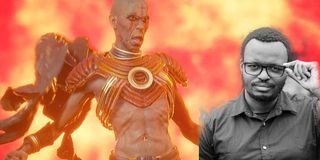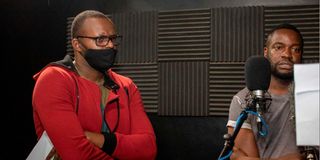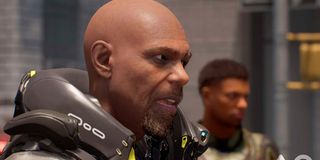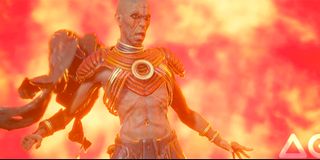A deep dive into computer generated imaging

Animator Andrew Kaggia, the brains behind the computer-generated imagery film TeraStorm.
A movie idea hits a young man. The man is into animations, superheroes and comics. Later, he looks for a comics illustrator. Characters are drawn on a piece of paper.
A while later, the man recreates those illustrations on a computer. He creates skin tones with a stunning imitation of life. Their eyes blink, their foreheads have life-like creases and their tongues dance between the teeth during dialogue. Literally, life is breathed into the cold illustrations. Two-dimensional becomes three-dimensional and every character is made to fit in a distant world.
That way, a Kenyan-made computer-generated image (GCI) movie is born. TeraStorm is its title and it is 82 minutes long. It is described as an adventure, action and thriller movie wrapped into one.
The movie was on the menu for Nairobi patrons of the Century Cinemax for days after its November 24 premiere. Until Thursday (December 9), it was airing in Kisumu at the Mega Cinemas.
The young man behind all this is 34-year-old Andrew Kaggia, a man who once refused to join the University of Nairobi (UoN) to study economics because he thought he had a brighter future elsewhere.
“I didn’t even enrol. I just reached the gate, stood there for an hour then left. I thought about my life for long as I stayed there, watching people go in and out. And I said, ‘Hapana, I can’t do it,” Andrew tells Lifestyle.
He might have been right, though it was difficult for his father to see life from his point of view. He is the lastborn in a family of five children. Musician Dennis Kaggia alias DNA – he of the Banjuka fame – is the second born and his only brother. Tina Kaggia, the third born, is one of Andrew’s three sisters and is a well-known media personality.
Andrew told Lifestyle that he spent a year and a half making this film, working an average of 16 hours a day, sometimes very late into the night.
“There are days I didn’t even leave the room. I would just stay there, work, sleep, and order my food from there,” he says.
He used two powerful computers for this, and part of the funding came from a company called Epic Games.
“They are the developers of the software I used to make TeraStorm,” says Andrew.
“Two years ago, I’d done a small sample that ended up becoming TeraStorm. And I showed it to them (Epic Games) and they liked it, so they gave me a small grant which helped me to work on TeraStorm.”
He finished the film in July, and he submitted it to the Kenya Film Commission to be considered as the Kenyan candidate in the 2023 edition of the Academy Awards (Oscars). After reviewing the entries submitted, TeraStorm got the nod.
Film TeraStorm
“The Oscar Selection Committee-Kenya has selected the Film TeraStorm by Afrikana Digital (a company founded by Andrew) as the Kenyan submission for the Best International Feature Film category for the 95th Academy awards popularly known as the Oscars,” tweeted the Kenya Film Commission on September 23.
Andrew hopes that, come March next year when the 2023 Oscars will be held, he will bag the prize.
“A few weeks after submitting, I got a call from one of the jury members that this had been selected to represent Kenya for the Oscars and I was very happy,” he says.
This is the first time he is submitting a film for consideration.
“I felt this film. It’s not every day we get animation films. It’s not every day we get such. So, I felt, ‘I think this has a chance.”
His love affair with such movies began at a tender age.
“Ever since I first saw cartoons on TV in the 90s, I was fascinated. I didn’t know the technical terms – animation or this and that – but I just remember watching cartoons and saying to myself: ‘When I grow up, I want to make those things.’ That is the only language I had,” he says.
He adds: “In 1995, I watched Jurassic Park, the dinosaur movie. Then I remember my brother telling me the dinosaurs weren’t real. I couldn’t understand what he meant by saying they were not real because I was seeing them eating people, chasing cars. So, I said, ‘Haiya! So, you mean, there is a way to make things, add things in a movie that are not real but they look real?’ My mind was piecing together all those things, and from there, I was addicted to looking for that kind of content. So, any time I saw something that was in 3D on TV, I was fascinated.”

Animator Andrew Kaggia (right) during the voicing of the movie TeraStorm. He is with Melvin Alusa, who voices Ammadu in the movie.
That fascination placed him on a path to teaching himself how to animate. Some of it happened by chance, like when he asked his sister Caroline who was in Malaysia then to bring him video games but she mistakenly brought animation software.
“She thought they were games. So, by fate, she brought the software for making these things, thinking they were the games, so, I got the opportunity. We had an old computer and I installed them and started playing with them, even without tutorials or anything. I just installed it and started messing around with it. That was in 2003, and that’s basically where it took off. I said, ‘This is what I want to do for life,” he comments.
TeraStorm is the biggest such undertaking he has carried out, but he has done a couple of productions before, some that have gone viral on YouTube.
One of his videos, a three-minute animation uploaded six years ago on his YouTube channel called HeroSmashers, has 293 million views. The second most viewed video, which is a minute and 43 minutes long, was uploaded two years ago and it has been viewed 53 million times.
He was at the Anga Cinema at Diamond Plaza on November 24 when TeraStorm premiered, trying as much as possible not to be recognised, and he says the response was encouraging.
Realistic
“There are some people who couldn’t believe it was an animation. Some thought it was real because the characters looked very realistic. I remember one lady saying: ‘This isn’t an animation.’ People were very happy about it, and I was also happy to see all the reactions,” he says.

A screengrab showing the characters in Andrew Kaggia's movieTeraStorm. Characters were developed through computer-generated imagery.
“And then at the end, I stood up to thank the audience for watching TeraStorm. Then they knew who I was.”
The movie has not earned him much in terms of cash returns but since it has so far only aired in cinemas, Andrew hopes he will reap benefits when he places it on other distribution channels.
“I am thinking of placing it on a pay-to-view online platform once it’s done with the cinema. There are a lot of people who are asking about it, even outside Kenya. They don’t have access now,” he says.
Since that day when he let his admission to the UoN slip, he has not bothered with formal education. He even has no idea where his Kenya Certificate of Secondary Education examinations certificate is.
“I remember telling my dad, ‘Just give me six months. I think I can figure it out after six months.’ And the six months passed, and I told him, ‘Give me another six months.’ He wasn’t very happy to hear that,” says Andrew.
Now he is confident of his skills in animation, all self-taught.
“I didn’t go to any university to study animation. In fact, when I was doing this, there weren’t such types of colleges in Kenya. Nowadays, there are a lot of animation courses all over, but when I started, they weren’t there, so, I am self-taught, just from reading books,” he says.
TeraStorm is a combination of concepts that Andrew holds dear.

A screengrab showing the characters in Andrew Kaggia's movieTeraStorm. Characters were developed through computer-generated imagery.
“The plot is inspired by my love for African mythology and superheroes and science fiction. Of course, I am a big fan of superheroes like Marvel DC and such. And I’m also a huge fan of African stories, the stories of mythology: the likes of Luanda Magere and such. So, I wanted to come up with my own unique story that combines the two elements – the African mythology side and the science-fiction side,” he says.
The official synopsis of the film gives a glimpse of his world-view. It reads: “When an ancient artefact is discovered by KifaruTek, its lead scientist and founder Victor Thimba attempts to harness its mysterious energy in a secret operation dubbed ‘Project Lightstorm’ – a programme that manufactures highly advanced weapons and military tech for top world governments. An ambush takes place at KifaruTek, as a mysterious attacker breaks in and steals the artefact, using its power to resurrect Eli-Ra, an ancient wizard demigod.
The fate of the planet lies in the balance and a group of brave heroes join forces to battle an enemy more powerful and sinister than they could possibly imagine. Fuelled by vengeful rage, Eli-Ra plans to enslave humanity through a ‘baptism of fire’. The brave heroes must be willing to put their very lives on the line to defeat Eli-Ra before his barrage of devastation and ruin puts an end to humanity. However, it may be too late to save the planet from the onslaught.”
Andrew says that as he was creating the movie, simple things such as clothes and strands of hair were painstakingly hard to create.
“Clothes are based on physics. You have to calculate some physics, and it’s stressful,” he says.
“Also, there is a character who has dreadlocks. To make their dreadlocks properly react to the movement is very, very difficult.”
Computers used for such endeavours are custom-made because Andrew says it is hard to get one machine that has all the required characteristics in one package.
“You pick the right pieces that you want. You get a nice graphics card, you get RAM (random access memory) of a certain size, a processor of a certain size, then you assemble. That’s what I’ve been doing for many years,” he says.
“But eventually (the machines I had) weren’t even enough because they kept crashing and all. I needed better hardware, but it was tricky because there were hardware shortages for the graphics card, so, I just worked with what I had,” he adds.
So, what was the experience like, getting the film to air in local cinemas?
“It’s not easy; especially this time. This was launching just after Black Panther, and Black Panther is a big film, so, it was a bit of a tricky one. So, you have to convince the cinemas that the movie is also something that people would want to watch. Because of course, they give the best times to the biggest movies, so you have to convince them that this is a movie worth putting there because it will bring a good amount of money that makes it worth allocating a certain amount of time. So, we talked to the cinemas – but of course, they have to watch the movie to make their judgment – and most of them liked it a lot because there hasn’t been an African animation on the big screen before. They liked the movie and were like, ‘Fine, we can do this. We can have it on our screens,” he says.
Morietz Muthui
The credits that accompany TeraStorm reveal that the movie was not a solo effort. Among the people who played a part in its creation is Morietz Muthui, the illustrator who put the characters on paper before Andrew brought them to life.
Then there is Firul Maithya who was the line producer. There are also voice actors including Arabron Nyyneque, Ali Mwangola, Melvin Alusa, Sarah Muhoho, Marianne Nungo, and Mungai Kiroga.
“I didn’t have mega millions of dollars in budget but still we’ve done our best to reach this level of Oscars” says Andrew.
eondieki@ke.nationmedia.com


